Apartment heating: how to equip an individual heating system
Today, the only decent alternative to district heating is apartment-based heating. At the same time, its development requires a significant investment of time, effort and money, but as a result, the investment pays off in a perfectly acceptable period.
In our article we will analyze the pros and cons of such systems, as well as give recommendations for their installation.
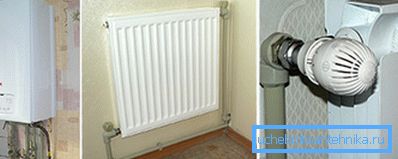
Feasibility study
Why centralized heating is inefficient?
Today, most apartment buildings have centralized heating systems. At the same time, only radiators and supply pipes are placed in the apartments, and the heating medium is heated at special facilities (boiler houses and CHP). These enterprises can be located at a considerable distance (up to several kilometers) from the point of heat consumption, which determines the key disadvantages of the system.
The low efficiency of centralized heating is due to such factors:
- First of all, Quite a lot of boilers use outdated water heating and steam generating equipment with low efficiency. At the same time, the burning of large amounts of fuel leads to an increase in financial costs, and huge amounts of carbon monoxide and other combustion products get into the air.
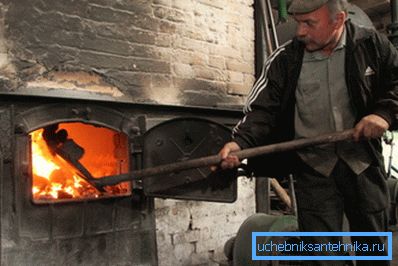
- Secondly, transporting the coolant over long distances leads to the fact that its temperature is significantly reduced. Especially great heat loss in winter, during the most active heating. Some of them are trying to compensate for them by increasing the temperature of the water supplied to the pipes, but this again leads to an additional cost.
Note! According to the SNiP, all external pipelines must be equipped with insulating shells. In practice, from one third to one half of the heating mains do not have a quality heat saving circuit, so often CHP plants heat not so much apartments as the environment.
From the point of view of the recipient of heating as a service, the centralized scheme is also very inconvenient:
- On the one hand, the indoor temperature is almost impossible to control either up or down. So the situation is quite real when you will be forced to wrap up in wool sweaters, waiting for the temperature of the water in the pipes to be raised at the CHP.
- On the other hand, the stumbling block is the question of the beginning and end of the heating season. Yes, there are certain standards that stipulate the inclusion of heating equipment, but they are not very flexible, and therefore in late autumn we get cold for at least a week, waiting for “to give heat”. Well, in the spring you have to open the windows, because the batteries are also not immediately disconnected.

However, most often the transition to apartment heating is determined by financial considerations. Agree where it is more logical to independently control the microclimate in the room, and pay only for the fuel used for its intended purpose, and not to finance the transportation of hot water through unheated pipes.
Advantages and disadvantages of apartment heating
Before deciding to install an autonomous heating, it is necessary to analyze its pros and cons.
The strengths of this technology include:
- Fast enough payback. Due to the savings on energy costs, you can completely “break into zero” after five to seven years of operating the system.
Note! These terms are valid only in the case of rational use of heat. If the boiler will operate continuously at maximum power, while to reduce the temperature you will open the windows (and even more so - turn on the air conditioner), then the savings will be close to zero.
- Comfortable microclimate adjustment. You yourself set the appropriate temperature in the room, and the boiler automatically maintains it. The highest quality models can be connected to room thermostats, so that the degree of air heating will not depend on the outside temperature.

- Environmental friendliness. Modern models of heating boilers are distinguished by the maximum complete combustion of fuel, which allows minimizing emissions to the atmosphere.
- Reduced construction costs. Data plus is relevant primarily for construction companies: when laying in a project for apartment heating, it is not necessary to allocate funds for the installation of heating mains and connection to the main line.
Of course, there is a system and cons:
- First of all, the price of the equipment itself is quite substantial. For many, such a one-time investment will be “overwhelming”, so you have to either take out a loan with all the attendant risks, or you can save money for several months.
- Secondly, The installation of heating equipment in buildings where centralized heating was previously installed is associated with very labor-intensive bureaucratic procedures.
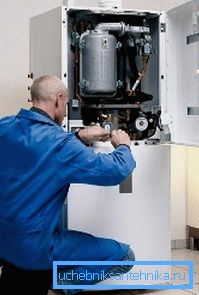
- Thirdly both during installation and operation of the system, close attention must be paid to safety issues. This requirement is particularly relevant for gas boilers: you should not install them yourself, since only employees of certified services are allowed to work with gas equipment.
Arrangement of individual heating
Legal aspects
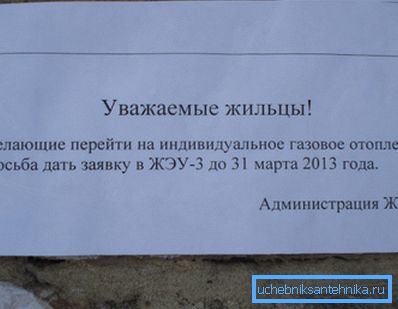
The process of transition to autonomous heating must begin with obtaining permits.
The approximate algorithm of work will be as follows:
- To begin to clarify the technical ability to disconnect from centralized heating. This moment is the most difficult, since the operating organizations agree to such a move extremely reluctantly.
Note! The probability of a court decision in your favor will be higher if you contact a lawyer who specializes in such matters. Also good results are given by collective applications from all house or an entrance.
- Next, we turn to the project organization, which must develop the technical conditions for the connection, including drawings for the connection of gas pipes, placement of heating circuits, etc.
- The next stage is fire supervision. If the building is made of non-combustible materials (brick, concrete), then obtaining the act usually does not cause problems.
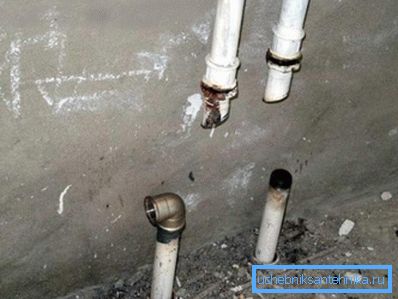
- Then we purchase equipment (we will talk about the choice in the next section) and contact the installation organization. Its representatives are obliged to request certificates from you for compliance of the boiler with accepted standards, therefore, when purchasing an aggregate, it is necessary to pay special attention to this.
- Next, the installation itself, the connection of the boiler by the specialists of the gas industry, as well as the registration of equipment and service. After that, the operating organization should receive from you a notice about the transition to the autonomous heat supply of the apartment.
Note! Forms of documents should be coordinated with the organization to which you will submit them. Of course, the instruction assumes the existence of a unified state standard for issuing such papers, but very often organizations set their own internal rules.
Heater selection
For an apartment heating system, it is necessary to choose a hot water boiler. And here we need to decide on the power of the device, and on the type of fuel used - gas or electricity.
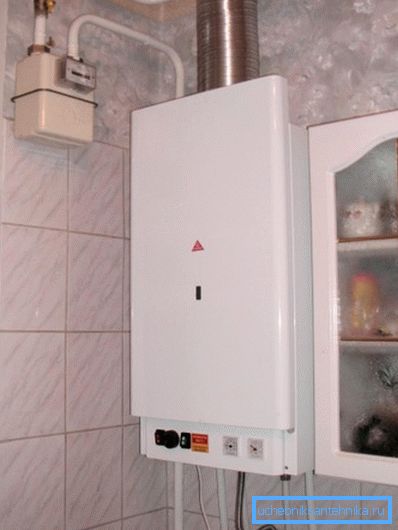
As far as productivity is concerned, everything is quite simple: a minimum of 100 kW of boiler power is required for heating every square meter of space. Therefore, an apartment of 50 m2 Need a machine of at least 5kW.

As for gas and electricity, the choice is more difficult to make. To analyze the strengths and weaknesses, we structured the information in the form of a table:
| Type of boiler | pros | Minuses |
| Gas |
|
|
| Electric |
|
|
However, gas devices are still more popular, so they are likely to recommend them. On the other hand, electric boilers can be installed in non-gasified buildings.
Peripheral installation
Finally, for heating it is necessary to mount pipelines and radiators.
And although there are quite a few differences from centralized heating, you should pay attention to them:
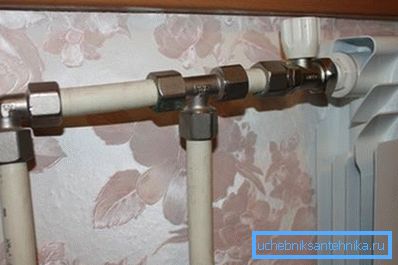
- The peculiarity of individual heating is the low pressure in the system and the absence of temperature changes. It leaves its mark on the process of selecting components.
- So, instead of steel pipes, you can use polymer or metal-plastic products. They are practically not subject to corrosion, but at the same time they have sufficient temperature and deformation resistance.
Note! Part of the pipes can be laid in the floor screed, ensuring the heating of the lower layer of air. It will be more rational than the arrangement of underfloor heating with connection to central heating radiators.
- Radiators can be taken less durable, but more efficient in terms of heat transfer. So, it is the installation of apartment heating that makes it possible to use aluminum batteries: since hydraulic shocks do not threaten the circuits with pressure testing, then there should be enough stability in 25 atmospheres.
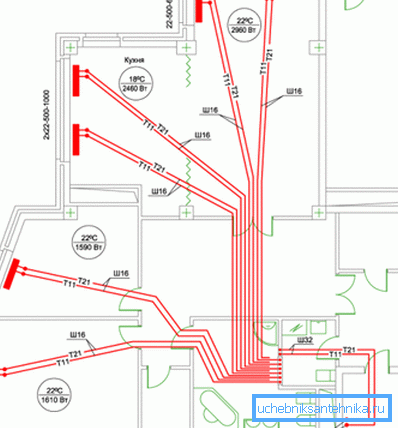
- Also at installation of individual heating use of bimetallic radiators justifies itself. Due to the high heat transfer of such products, it is possible to maintain a lower temperature in the pipes, which makes it possible not to overpay for gas even in the cold season.
As for the assembly of the circuits, there should be no difficulties: the metal parts are connected either by welded or threaded fittings, and for fixing polyethylene pipes we use the technology of high-temperature soldering.
Tip! Before starting up the system, it is imperative to check for tightness.
Conclusion
Despite the complexity of implementation, apartment-based heating systems have a number of tangible benefits. So, in order to reduce the cost of heating the apartment, it is quite possible to equip an autonomous heating circuit, following the recommendations given in the article and shown in the video. Of course, the payback period will be considerable, but as a long-term investment this technology fully justifies itself.